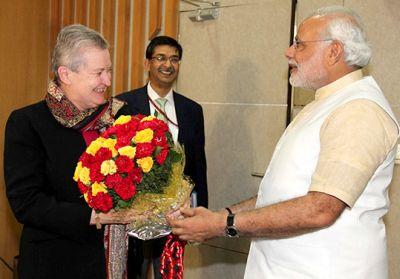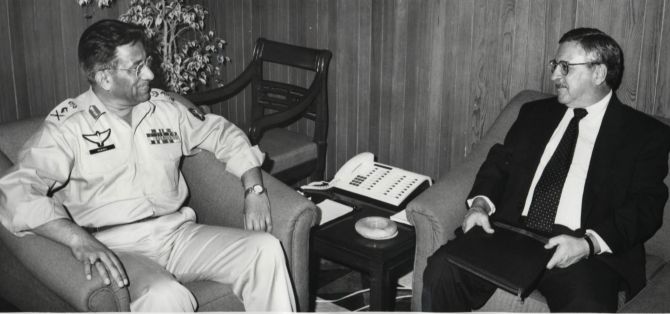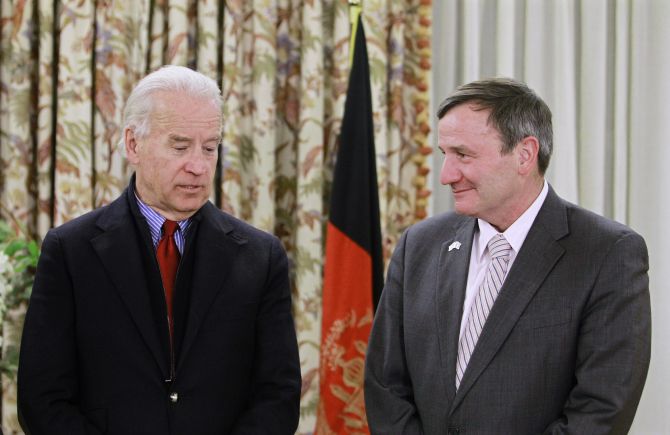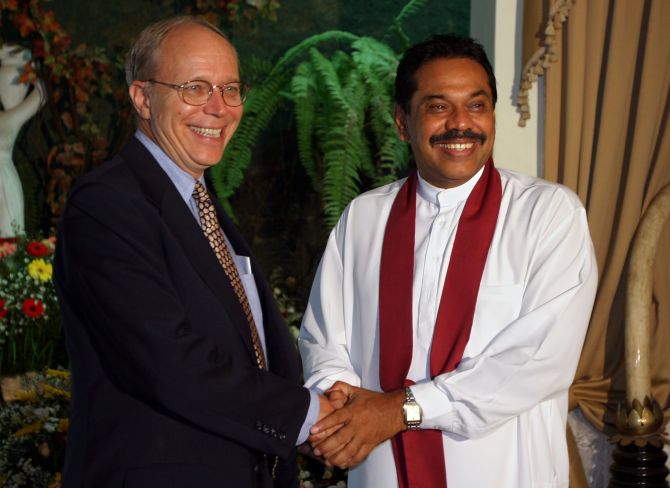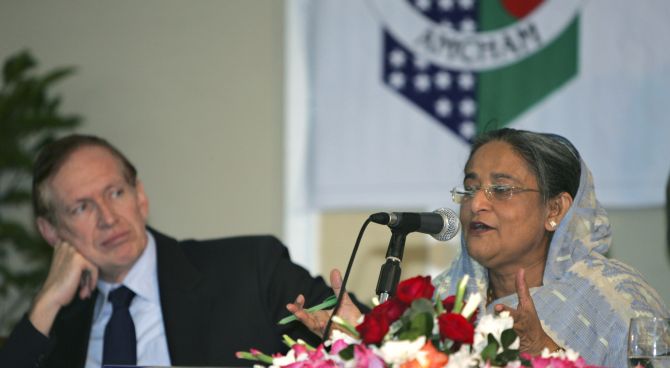 | « Back to article | Print this article |
Do career diplomats make for better US ambassadors to India?
'A good ambassador needs to know, and to represent, the interests of the United States. In South Asia, career officers have done well by this standard; so have most of the non-career appointees.'
Career diplomat Nancy J Powell, the US ambassador to India, resigned on Monday. Retired United States ambassadors Howard B Schaffer and Teresita C Schaffer look at how political appointees and career diplomats sent as envoys to India and South Asia have fared over the years.
The brickbats cast at the Obama administration for appointing unqualified candidates to important ambassadorial jobs notably did not include any directed at envoys to the South Asian countries.
Unlike the representatives US President Obama has nominated this year to the fleshpots of Western Europe and other comfortable parts of the world, all six American ambassadors assigned to South Asia are career Foreign Service officers, five with previous experience in their host countries or elsewhere in the region.
Campaign bundlers and other would-be politically-appointed ambassadors haven't been breaking down the doors to reach this challenging and often dangerous part of the world. With some noteworthy exceptions, mostly but not exclusively in India, those among them who have been chosen have not brought assets to their embassies that Foreign Service officers could not have provided. The South Asia experience makes a good case for the assignment of FSOs as ambassadors.
India
This career appointee monopoly is unusual in South Asia. For years assignments to the demanding job of ambassador to India and to other chief of mission positions in the region have been given to both political appointees and career diplomats.
Most of the non-professional ambassadors sent to India had had impressive careers before reaching New Delhi. Though there were some weak reeds among them -- as there were among the career appointees who served there -- for the most part they carried out their jobs well.
Recent politically appointed ambassadors have generally had successful prior careers in American public life.
Richard Celeste, a Clinton appointee, was governor of Ohio and head of the Peace Corps.
Much earlier, in the 1960s, he had played an important role at Embassy New Delhi as special assistant to Ambassador Chester Bowles.
David Mulford, sent to India by George W Bush, had been undersecretary for international affairs at the treasury before taking on the New Delhi assignment at a crucial time in bilateral relations. His successor Timothy Roemer, an Obama appointee, had been a senior member of the House of Representatives. Only the most rabid advocates of the 'leave diplomacy to the diplomats' school can seriously fault these assignments.
The career officers recent administrations have sent to Embassy New Delhi have also been highly regarded. They include two Foreign Service officers who are legendary diplomatic figures in their own time, Thomas Pickering and Frank Wisner.
The highly talented incumbent, Nancy Powell, the first American woman assigned as ambassador to India, is now on her third assignment there. She has also served as ambassador to Pakistan and to Nepal and has held other senior positions in the region. She was also ambassador to two African countries.
The practice of mixing political and career appointees in assignments to New Delhi dates back to the 1980s. For the quarter century before then, successive administrations were persuaded that only nominees with claims to importance in public life and to personal access to the president and other top US leaders would be acceptable to the Indian government.
Conventional wisdom had it that the Indians would regard the appointment of a 'mere' Foreign Service officer as a signal that the United States had downgraded the importance it gave their country.
Many of the political appointees who were assigned to Embassy New Delhi in those years had in fact had distinguished roles in public life and could plausibly claim that they knew their way around the White House and other Washington foreign policymaking circles. But not all of them proved effective either in helping shape the policies Washington pursued toward India or in winning the personal and professional regard of the Indian government.
Some, such as Ellsworth Bunker and Chester Bowles on his first Delhi assignment, were superb chiefs of mission; others, like Bowles on his second ambassadorial posting and his successor Kenneth Keating had little influence either at home or in India.
This longstanding practice of 'No career diplomat need apply' ended with the appointment of FSO Harry Barnes as ambassador in 1981. Barnes, who served in New Delhi at a difficult but promising period in US-Indian relations, came to be regarded by Indians and Americans alike as one of the best ambassadors Washington had assigned there.
Unlike many of the political appointees, he was superbly aware of the Washington power structure and process, and knew where to plug in to maximise his influence on policymaking. If the Indians had any complaints about being 'downgraded' in America's regard, they never voiced them.
Kindly click NEXT to read further...
A tough assignment and in recent years a dangerous one
Pakistan
Before its breakup following the 1971 Bangladesh War, a number of non-career ambassadors were assigned to Pakistan. But since that time, all the ambassadors sent to Islamabad have been career officers.
This probably reflects Pakistan's diminished attractiveness to would-be political candidates for the job. It has become a tough assignment and in recent years a dangerous one. Political appointees posted to Pakistan earlier worked in more pleasant circumstances -- though riding the roller-coaster of US-Pakistan relations often posed substantive challenges.
These earlier appointees would not have enjoyed life as much at the present-day mission, where the embassy staff, separated from their families, huddle behind compound walls, travel in heavily guarded convoys, and must deal with an unending procession of high-level official visitors from Washington.
Most of the career appointees assigned to Pakistan in recent years had not previously served there or elsewhere in South Asia. Notable exceptions included Nancy Powell, now ambassador to India; William Milam, who had been ambassador to Bangladesh; and Arnold Raphel, who had served as a deputy chief of Embassy Islamabad's political section.
Raphel, an outstanding officer who was ambassador in the late 1980s, was killed while travelling with then Pakistan president Zia-ul Haq when the president's plane mysteriously exploded.
Almost all of the career ambassadors were highly regarded as skilled professional diplomats both in Washington and by the Pakistanis with whom they worked. As a group they were considered far more competent than some of the political appointees -- such as West Virginia coal mine operator Joseph Farland, President Nixon's poor choice for the job -- who served as ambassadors during the earlier period.
Kindly click NEXT to read further...
Mission Kabul
Afghanistan
The United States first established a diplomatic mission in Kabul during World War II.
Earlier, the chief of the US mission in Tehran had been dually accredited to Afghanistan. Of the resident ambassadors who served between then and the decision to limit relations with the Communist government that held power during the Soviet occupation of the 1980s, all but one were career officers.
The exception was Robert Neumann, a prominent academic who was appointed by President Johnson and carried on under Nixon. (Neumann's son Ronald, a career Foreign Service officer, served in the same position during the George W Bush administration.)
The last of this early series of ambassadors to Afghanistan was Adolph Dubs. Dubs, a Soviet expert, was kidnapped by an extremist group in Kabul and tragically killed during a botched rescue operation.
Full US-Afghan diplomatic relations were only restored after the overthrow of the Taliban regime in 2001. Most of the ambassadors subsequently assigned were career officers. There were two notable exceptions. One was Zalmay Khalilzad, who served in Kabul for a year-and-a-half during the first George W Bush administration.
An Afghan by birth and an academic by background, Khalilzad had earlier been a senior Afghanistan specialist on the staffs of the National Security Council and the State Department. He typifies the academic who parlays his skills into an influential Washington policymaking position and then an ambassadorial assignment. He went on to serve with distinction as ambassador to Iraq and the United Nations.
The other non-career officer to lead Embassy Kabul was Lieutenant General (retired) Karl Eikenberry. Eikenberry's appointment was remarkable in that he had earlier served twice in the North Atlantic Treaty Organisation-led military operation in Afghanistan, the second time as chairman of the Combined Forces Command not long before he took over as ambassador.
Kindly click NEXT to read further...
Mission Colombo
Sri Lanka
For many years, Washington sent a mix of career and non-career ambassadors to head the embassies in Colombo and Kathmandu. More recently only career officers have been assigned there.
It seems likely that as with Pakistan the deterioration of the quality of life for diplomats in both countries reduced the enthusiasm of would-be political appointees to seek these posts.
Both embassies, along with the embassy in Bangladesh, are often awarded to senior regional specialists who have served many tours of duty in South Asia and in Washington positions dealing with the region.
Before Sri Lanka became less attractive to would-be political appointees, the Eisenhower administration named Kentucky retail store magnate Maxwell Gluck as ambassador. At his Senate confirmation hearing Gluck was famously unable to name the head of the Sri Lankan government. This classic diplomatic gaffe is still remembered more than a half century later.
The New York Times cited it in a front-page story it ran on the inability of Obama's ambassadorial nominees to answer senators’ questions.
A far better appointment to Embassy Colombo was the Carter administration's choice of W Howard Wriggins, a highly regarded academic expert and writer on Sri Lankan matters.
Wriggins was sent there following Washington assignments dealing with South Asian affairs at the National Security Council and the State Department. He sought, rather unwisely in our view, to maintain both his diplomatic and academic personae while serving as ambassador.
When we questioned the appropriateness of his making no secret of his writing, as ambassador, a biography of incumbent Sri Lankan President J R Jayawardene and interviewing the president in the process, he was quite unperturbed. He told us that when he went to the president's residence for an interview, he used his own small car, not the ambassadorial limousine!
Kindly click NEXT to read further...
Mission Dhaka
Bangladesh
Bangladesh stands out as a model for proponents of assigning professional diplomats to ambassadorial jobs. In the 42 years since the United States (rather belatedly) recognised independent Bangladesh in 1972, all 14 ambassadors have been career officers. (One of these was from the US Agency of International Development. The rest have been regular Foreign Service officers.)
As noted, many of the ambassadors came to Dhaka with considerable regional experience. To cite only the more recent ones, James Moriarty had already been ambassador to Nepal and acting assistant secretary for South and Central Asian affairs before reaching Bangladesh.
His successor, Dan Mozena, who now heads the embassy, was political counselor there in an earlier incarnation and had also served at Embassy New Delhi.
What about those brickbats hurled at recent Obama appointees? Some were clearly deserved, such as the one cast at the nominee for Norway for incorrectly characterising an anti-immigrant political party that turned out to be a member of the government.
The inability of the nominee to Hungary to recall US strategic interests there merited another 'ouch'. But some of the criticisms were hardly 'hanging offenses'.
Ambassadors have served well without being lifelong scholars on their country of assignment, or indeed without having traveled there before. As the South Asian experience suggests, the important qualifications include knowing the dynamics of the region and its relations with Washington, and putting in the hard work of building relationships, both personal and official.
Perhaps most importantly, a good ambassador needs to know, and to represent, the interests of the United States. In South Asia, career officers have done well by this standard; so have most of the non-career appointees.
Howard B Schaffer and Teresita C Schaffer are retired United States ambassadors, and co-editors of southasiahand.com, where this article appeared first.
